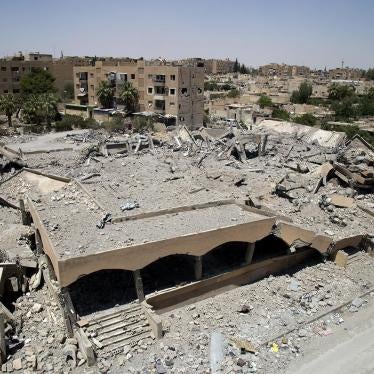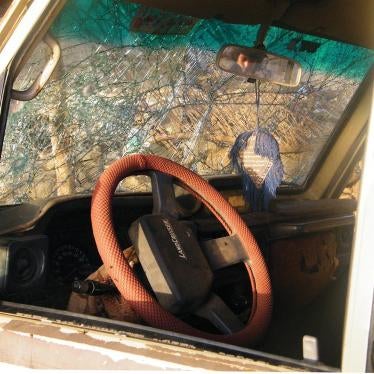This Technical Briefing Note reviews the use of cluster munitions in the conflict in Yemen since a Saudi Arabia-led coalition of nations began military operations against Ansar Allah (Houthi forces) on March 26, 2015. This is not the first time cluster munitions have been used in Yemen. Previously, Saudi Arabia and the United States, and likely the Yemeni government, used cluster munitions in separate attacks in different parts of the country in 2009.
Since March 2015, Human Rights Watch has recorded incidents involving six types of air-dropped and ground-launched cluster munitions in multiple locations in at least five of Yemen’s 21 governorates: Amran, Hajja, Hodaida, Saada, and Sanaa. Human Rights Watch believes the Saudi Arabia-led coalition of states operating in Yemen is responsible for all or nearly all of these cluster munition attacks because it is the only entity operating aircraft or multi-barrel rocket launchers capable of delivering five of these types of cluster munitions. However, in one case involving one type of ground launched cluster munition (the ZP-39), both Coalition and Houthi forces possess weapon systems capable of delivering it so it is not possible at this time to attribute responsibility for its use.
Human Rights Watch and others documented numerous civilian casualties from the use of cluster munitions, both at the time of attack and afterwards as unexploded submunitions were encountered. For example, a series of cluster munition rocket attacks in Yemen’s northwestern Hajja governorate between late April and mid-July 2015 killed at least 13 people, including three children, and injured 22 people at the time of attack and three more after the attack from unexploded submunitions.
Neither Yemen nor Saudi Arabia and the other countries participating in the coalition are party to the 2008 Convention on Cluster Munitions, the international treaty banning cluster munitions. A total of 118 countries have signed and 98 have ratified the treaty. Human Rights Watch is a co-founder of the Cluster Munition Coalition and serves as its chair.
Methodology
This Technical Briefing Note draws on evidence collected, including witness accounts, in the course of field investigations by Human Rights Watch researchers in Yemen. It also reviews evidence from a number of other sources, including:
- Photos and testimony collected and published by Amnesty International;
- Videos and photos taken by local and international journalists and shared on Twitter, Facebook, and directly with Human Rights Watch;
- Video and still photographs provided to Human Rights Watch by individual Yemeni citizens;
- Threat information shared with Human Rights Watch by international demining experts and armament research specialists;
- Cluster Munition Monitor 2015 Yemen profile. http://www.the-monitor.org/en-gb/reports/2015/yemen/cluster-munition-ban-policy.aspx
Types of Cluster Munitions
At least six types of cluster munitions have been used in Yemen since March 2015: four types of air-dropped bombs and two types of ground-launched rockets. This includes an unknown system used to deliver “ZP 39” submunitions.
Cluster munitions used in Yemen since March 2015
|
Type of cluster munition |
Governorate and date first used |
Stocks possessed by |
|
Air-dropped |
||
|
CBU-105 Sensor Fuzed Weapon that deploy 10 BLU-108 canisters, each releasing four submunitions called “skeet” by the manufacturer. |
Saada (Apr 2015) Sanaa (May 2015) Amran (Jun 2015) Hodaida (Dec 2015) |
Saudi Arabia, United Arab Emirates |
|
CBU-87 bomb, each containing 202 BLU-97 submunitions |
Saada (May 2015) |
Saudi Arabia |
|
CBU-58 bomb, each containing 650 BLU-63 submunitions |
Sanaa (January 2016) |
Saudi Arabia, Morocco |
|
Ground-launched |
||
|
ASTROS II rocket, each containing up to 65 submunitions |
Saada (Oct 2015) |
Bahrain, Saudi Arabia |
|
M26 rocket, each containing 644 M77 Dual Purpose Improved Conventional Munition (DPICM) submunitions |
Hajja (Apr 2015) Saada (Jul 2015) |
Bahrain, Egypt, United Arab Emirates |
|
“ZP 39” DPICM submunition (delivery system not known) |
Saada (Apr 2015) |
Not known |
Photographs circulated on social media in January 2016 showed the remnants of UK-manufactured BL755 cluster bombs and their submunitions, reportedly situated in Yemen, but Human Rights Watch has not been able to verify the photographs or attain additional evidence to confirm use.
Cluster Munition Attacks in Yemen since March 2015 Documented by Human Rights Watch
|
Location |
Date of Attack |
Cluster Munition Type |
Submunition Type |
|
Al-Shaaf, Saada |
April 17, 2015 |
CBU-105 |
BLU-108 skeet |
|
Al-Amar, Saada |
April 27 |
CBU-105 |
BLU-108 skeet |
|
Baqim, Saada |
April 29 |
Unknown |
ZP-39 DPICM |
|
Bani Kaladah, Hajja |
Late April/Early May |
M26 |
M77 DPICM |
|
Sanhan, Sanaa |
May 21 |
CBU-105 |
BLU-108 skeet |
|
Al-Nushoor, Saada |
May 23 |
CBU-87 |
BLU-97 |
|
Al-Maqash, Saada |
May 23 |
CBU-87 |
BLU-97 |
|
Al-Hazzan, Hajja |
Late May/Early June |
M26 |
M77 DPICM |
|
Malus, Hajja |
June 7 |
M26 |
M77 DPICM |
|
Harf Sofian, Amran |
June 29 |
CBU-105 |
BLU-108 skeet |
|
Dughayj, Hajja |
Late June/Early July |
M26 |
M77 DPICM |
|
Al-Qufl, Hajja |
July 14/15 |
M26 |
M77 DPICM |
|
Haradh, Hajja |
July 25 |
M26 |
M77 DPICM |
|
Al-Fajj, Hajja |
July 25 |
M26 |
M77 DPICM |
|
Ahma, Saada |
October 27 |
ASTROS II |
ASTROS II |
|
Al-Hayma Port, Hodaida |
December 12 |
CBU-105 |
BLU-108 skeet |
|
Sanaa |
January 6, 2016 |
CBU-58 |
BLU-63 |
Responses to the Use of Cluster Munitions
While the government of Saudi Arabia has not issued a formal statement or response to requests to confirm or deny the reports that the Saudi-led coalition used cluster munitions in Yemen, the coalition’s principle military spokesperson Brig. Gen. Ahmed Asiri has commented on the matter in several interviews. In January 2016, Asiri told CNN that the Saudi Arabia-led coalition has used cluster munitions once and described the use of air-dropped CBU-105 Sensor Fuzed Weapons to attack a camp in Hajja governorate in April 2015. Asiri has denied other instances of use by the coalition, most notably a January 6, 2016 cluster bomb attack on Yemen’s capital Sanaa.
A US Defense Department official, speaking on the condition of anonymity, told U.S. News and World Report in August that “the U.S. is aware that Saudi Arabia has used cluster munitions in Yemen.”
The use of cluster munitions in Yemen has received worldwide media coverage, public outcry, and been condemned by more than a dozen states, including Costa Rica as president of the Fifth Meeting of States Parties of the Convention on Cluster Munitions. At the convention’s First Review Conference in Dubrovnik, Croatia, in September 2015, states also condemned the use of cluster munitions in Yemen and adopted a declaration condemning any use of cluster munitions by any actor. The United Nations, the International Committee of the Red Cross, and the Cluster Munition Coalition have also condemned the use of cluster munitions in Yemen. A resolution adopted by the European Parliament (EP) on July 9, 2015 condemned the Saudi-led coalition airstrikes in Yemen, including the use of cluster bombs. This Briefing Note provides summary information on cluster munition attacks in Yemen, but for more detailed information please see the following publications:
References
Human Rights Watch, “Yemen: Coalition Drops Cluster Bombs in Capital,” January 7, 2016, https://www.hrw.org/news/2016/01/07/yemen-coalition-drops-cluster-bombs-capital-0.
Amnesty International, “Yemen: Brazilian cluster munitions suspected in Saudi Arabia-led coalition attack,” October 30, 2015, https://www.amnesty.org/en/latest/news/2015/10/yemen-brazilian-cluster-munitions-suspected-in-saudi-arabia-led-coalition-attack/.
Human Rights Watch, “Yemen: Cluster Munition Rockets Kill, Injure Dozens,” August 26, 2015, https://www.hrw.org/news/2015/08/26/yemen-cluster-munition-rockets-kill-injure-dozens.
Human Rights Watch, “Yemen: Cluster Munitions Harm Civilians,” May 31, 2015, https://www.hrw.org/news/2015/05/31/yemen-cluster-munitions-harm-civilians.
Human Rights Watch, “Yemen: Saudi-Led Airstrikes Used Cluster Munitions,” May 3, 2015, https://www.hrw.org/news/2015/05/03/yemen-saudi-led-airstrikes-used-cluster-munitions.







